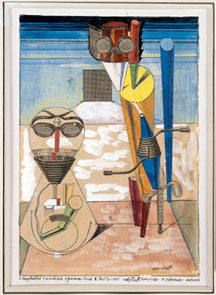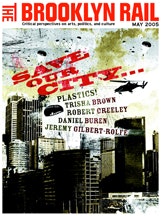ArtSeen
Max Ernst: A Retrospective
The Metropolitan Museum of Art
through July 10, 2005
 Max Ernst, “Ambiguous Figures (1 Copper Plate, 1 Zinc Plate, 1 Rubber Cloth…)” (1919/1920), collage, gouache, India ink, pencil and paint on print, mounted on paperboard. Collection Michael and Judy Steinhardt, New York ©2005 Artists Rights Society (ARS), New York/ADAGP Paris.
Max Ernst, “Ambiguous Figures (1 Copper Plate, 1 Zinc Plate, 1 Rubber Cloth…)” (1919/1920), collage, gouache, India ink, pencil and paint on print, mounted on paperboard. Collection Michael and Judy Steinhardt, New York ©2005 Artists Rights Society (ARS), New York/ADAGP Paris.The master is back. This major retrospective of Max Ernst (1891–1976) is a triumph, the first such gathering of works in 30 years and probably the best yet. Here are 175 works: collages, paintings, sculptures, Dada books, and memorabilia from private collectors, museums, and galleries around the world. The show was organized by Werner Spies, an Ernst scholar, and Sabine Rewald, contemporary art curator at the Met, and coincides with the opening of a new museum dedicated to Ernst’s life and work in his hometown of Bruhl, Germany.
Both alone and in collaboration with the most ingenious artists of the 20th century, Ernst helped pioneer the international movements of Dada and surrealism. His first great creative epiphany likely took place in 1912, when he saw a show in Cologne featuring the modernists in full splendor, including futurists, expressionists, and Pablo Picasso. This fateful exposure helped to turn Ernst away from his academic beginnings (his father was an art teacher) and led him down the cubist road and expressionist terrain beyond. His encounter with the metaphysical magic of de Chirico had yet more dramatic impact. Soon after, along with Theodore Baargeld and Hans Arp, he created a Dada section in Cologne (1919) and became the leading artist of the Dada movement, experimenting with Freudian images in a series of bold collages and paintings.
Of particular importance were the artist’s imaginative paper-collage novels, narratives made up of contradictory images culled from 19th-century engravings and combined in unsettling ways. Among the novels included at the Met are “La Femme 100 têtes” (1929), “Rêve d’une petite fille qui voulut entrer au Carmeld” (1930), and “Une semaine de bonté” (1934). They are hilarious, mysterious, and make you wonder.
Ernst invented and perfected the techniques of frottage (making a rubbing from a textured surface), grattage (scraping fresh paint from a canvas using a palette knife while pressing onto a textured object), and decalcomania (the manipulation of a wet painting by pressing a second surface against it and then pulling it away). In his paintings, Ernst explored themes arising from images of overgrown forests and ruined cities, which poignantly foreshadowed the political storm clouds gathering over Europe. “The Fireside Angel” (1937), for example, was in direct reaction to the menacing rise of fascism.
Among the highlights of the show are Ernst’s mysterious protosurrealist paintings. Based on the method of collage, they are built up of accidental, disparaged elements that create strange atmospheres, combining fear, comedy, and dream. Most famous among them are the iconic works created between 1921 and 1923, including “Celebes” (1921), in which a hulking, horned elephantine creature, part machine and part beast, stands on a vast plain against a cloudy sky, gazing at a headless female nude. In “Ubu Imperator” (1923), an anthropomorphic top dances in a vast, empty landscape. Such works captured early on the surrealist notion of estrangement and commitment to the subconscious, but also they seem surprisingly contemporary.
The red “Ubu Imperator” marked the entry of Ernst in the articulated stage of surrealism by his use of a literary narrative that was sometimes personal, sometimes political. In this seminal work a spinning top, a red carcass with iron reinforcement, and human hands express an astonishing image of the Ubu Father, a grotesque symbol of authority invented by Alfred Jarry. Other paintings suggest Ernst’s impressions of ancient Buddhist temples (à la Angkor Wat) as inspired from his trip to Asia following the breakup of his famous ménage à trois with Gala and Paul Eluard. This structure and thickly overgrown plants appear in many of his engravings and grattage oil paintings, such as “The Entire City” (1935–36) and “The Petrified City” (1935).
In the theoretical writing of “Beyond Painting” (1936), Ernst paraphrased Leonardo da Vinci on imaginary pictures evoked by stains on the walls, adding, “the role of the painter is to detect and project what is seen.” This could certainly apply to Ernst’s use of frottage, the artist noted, on August 10, 1925, in a hotel while he was staring at the wooden floor. There he used his “inner eye” to discover diverse animals, “the fiancé of the wind,” floating human heads, and more in the veins of the wooded floor, which he duly copied onto canvas using his unique technique.
Despite having a wife and son in Germany, Ernst was a playboy, and he enjoyed several love affairs, including one involving the surrealist artist Leonora Carrington, who had a nervous breakdown when Ernst was interned three times in French camps for enemy aliens. My favorite painting from this period is “The Robbing of the Bride” (1940), an oil on canvas with a giant female bird creature with cabaret-like red plumage. In 1941, with the assistance of Peggy Guggenheim, whom he married that same year, Ernst escaped to New York.
A special Ernst issue of View magazine published in 1942 and edited by poet Charles Henri Ford reignited an interest in the artist, and that same year found him showing in several successful exhibits in Chicago, New York, and New Orleans. At this time he also met American surrealist painter Dorothea Tanning at the Julien Levy Gallery, separated from Peggy Guggenheim, and moved to Sedona, Arizona, with Tanning. He married her four years later in a double ceremony together with his friends Man Ray and Juliet Browner.
Ernst was and still is accused by several art critics of borrowing or stealing images from other great masters (specifically from Henry Rousseau), using his unusually detailed memory of other’s artworks. But in my view, Ernst’s visual alchemy actually distilled and magically recomposed those symbolic surreal images, transforming them into pure dream symbols. Subsequently, his work wound up influencing other artists such as Yves Tanguy, Rene Magritte, and Salvador Dalí, along with later American artists such as Joseph Cornell, Ray Johnson, Robert Rauschenberg, John Digby, and even his granddaughter Emmy Ernst, an artist-collagist in her own right.
Following his American period (1941–1950), Ernst concluded that “Art is not produced just by one artist but by several.…It is to a degree a product of their exchange of ideas with one another.” True surrealists like Ernst believed that ideas and a theoretical framework are paramount to their creativity. A great catalogue published by the Metropolitan Museum of Art and edited by Werner Spies and Sabina Rewald, with essays by the curators and several distinguished scholars, accompanies this unforgettable retrospective.




